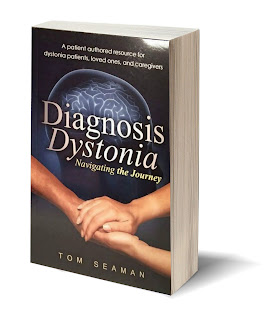I have lived with dystonia for over 15 years. For more than half of those years, I had a hard time asking for help. My ego stood in the way. I was certainly helped significantly by my loved ones, but it came with guilt, until I put myself in their shoes. They wanted to help. They just didn’t always know how and I didn’t know how to ask because I struggled with the reality that I had limitations.
When my symptoms were far more severe than they are now, I had to fly across the country to a clinic. Because of the intense pain standing upright and walking, my parents wanted to get a wheelchair for me to use in the airports. Just the idea of that at the time was beyond shocking….me, a former competitive athlete in numerous sports and well seasoned traveler needing a wheelchair? Never! Boy was that silly. I really needed that wheelchair, but because of my ego I suffered much more than I had to.
Quick side note - not long ago, I was in the hospital emergency room for an unrelated issue. I accepted a wheelchair every time it was offered. I even asked for one when it wasn't offered because I needed it. If only I did that in the airport. It would have been a much easier trip!
One of the emotional barriers asking for help is feeling guilty for having a condition where we need help. It causes us to experience negative feelings about ourselves; a sense of shame and unworthiness, which leads to isolation. Sharing our feelings with others helps break this isolation and any shame we might have.
I also become negligent asking for help because I felt like a burden to others. Ironically, they often felt guilty and a burden to me because they didn’t know how to help more. This is where clear communication is vital by letting others know what we need and also to let them know that we are here for them as well.
When I finally realized that it was okay to ask for and accept help, and that I was not being a burden, my life and those around me began to change. Life became much lighter for all of us. I learned that asking for help and relying on other people when necessary does not indicate weakness or failure. It is a sign of strength. It takes courage to admit we need help, especially when we are so used to an active, fully functional life.
We are also not the only ones who live with dystonia. Our friends and family experience pain as well, as they sit by feeling helpless watching their loved ones struggle. This can put a lot of stress on friendships, marriages, and other relationships to the point that they can be dramatically altered or even end. As much as we want to be understood by others, others want to be understood by us just as much. Please be sure to give your loved ones the opportunity to share what they are experiencing.
While some relationships have ended because of the life changes associated with dystonia, many new ones began and some existing ones have become stronger. It is all a matter of how we deal with it individually and collectively. We need to listen just as much as we talk, if not more. An open door policy with any challenge in our lives is the best way for us to help one another and strengthen our relationships.
Many helping hands are there for us. We just need to reach out. To feel comfortable allowing others to help us, we have to overcome the fact that we sometimes need help. All people do in one way or another.
Edited excerpt from the book: Diagnosis Dystonia: Navigating the Journey
Tom Seaman is a Certified Professional Life Coach in the area of health and wellness, and author of the book, Diagnosis Dystonia: Navigating the Journey, a comprehensive resource for anyone suffering with any life challenge. He is also a motivational speaker, chronic pain and dystonia awareness advocate, health blogger, and volunteers for the Dystonia Medical Research Foundation (DMRF) as a support group leader, for WEGO Health as a patient expert panelist, and is a member and writer for Chronic Illness Bloggers Network. To learn more about Tom’s coaching practice and get a copy of his book, visit www.tomseamancoaching.com. Follow him on Twitter @Dystoniabook1 and Instagram



No comments:
Post a Comment